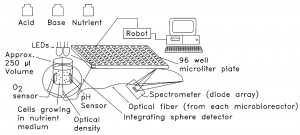 Presense Persuasion Sensing petitioned the USPTO to reexamine (invalidate) certain claims of U.S. Patent 6,673,532 (the ‘532 patent) directed to methods of measuring parameters in a cell culture. The USPTO rejected the challenged claims of the ‘532 patent as obvious in view of a combination of two references, which I will refer to as “Bamboo” and “Weigl.”
Presense Persuasion Sensing petitioned the USPTO to reexamine (invalidate) certain claims of U.S. Patent 6,673,532 (the ‘532 patent) directed to methods of measuring parameters in a cell culture. The USPTO rejected the challenged claims of the ‘532 patent as obvious in view of a combination of two references, which I will refer to as “Bamboo” and “Weigl.”
University of Maryland Biotechnology Institute (Maryland), which owns the ‘532 patent, argued that Bamboo and Weigl should not be combined because Weigl teaches away from the claimed invention. Maryland  alleged that Weigl taught away because “(1) Weigl’s carbon dioxide sensor is unstable; (2) each of Weigl’s flow-through units has only one sensor, not multiple sensors; (3) Weigl’s various outlets are inconsistent with the claimed invention’s ‘continuous volume’ limitation; and (4) Weigl’s device is “invasive” because it requires extra-vessel sensors.”
The court rejected these arguments on appeal. University of Maryland Biotechnology Institute v. Presens Precision Sensing GMBH, Nos. 2016-2745, 2017-1075 (Fed. Cir. 2017). The court found that Maryland’s teaching away arguments focused too narrowly on Weigl’s physical arrangement.
The court said, the “mere disclosure of alternative designs does not teach away.” Instead, “teaching away requires ‘clear discouragement’ from implementing the technical feature.” And the court found no clear discouragement.
When a reference teaches away from the proposed combination, such a teaching would discourage one skilled in the art from making the combination.
Therefore, teaching away is a good argument for defending against an obviousness claim. However, usually the teaching away needs to be quite explicit in the reference for the argument to have traction.